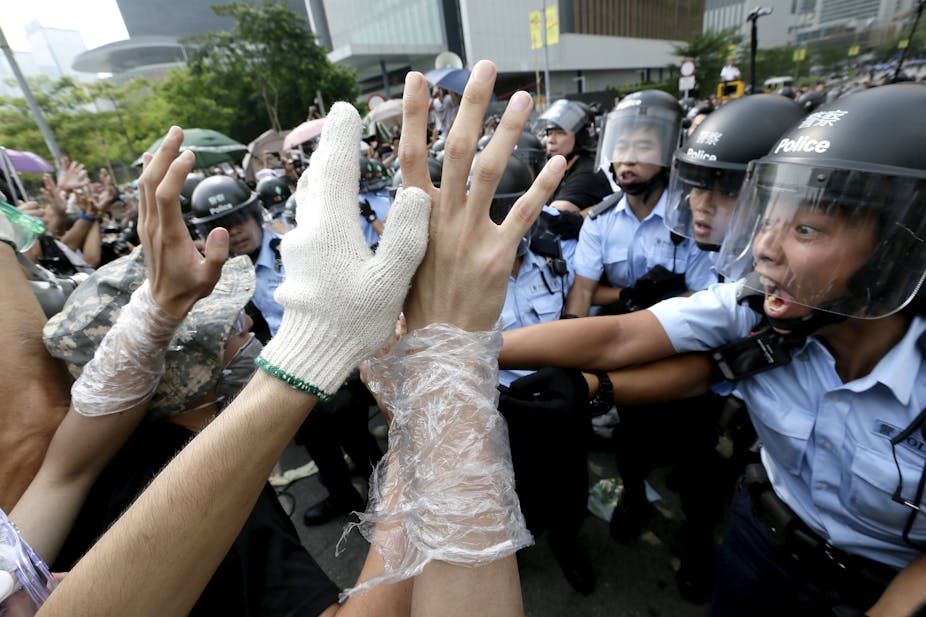The recent mass demonstrations in Hong Kong that have been calling for greater democracy saw the police initially responding with riot squads, tear gas and pepper spray against peaceful protesters. However, this authoritarian response merely caused the protests to grow, leading to the temporary withdrawal of the police.
On September 30, Human Rights Watch called for the authorities to avoid using excessive force and there was a stand-off during the national holiday to celebrate the founding of Communist China. Protesters had planned to occupy government buildings if the chief executive, CY Leung, didn’t stand down by midnight on October 2, resulting in a heavy police presence outside the chief executive’s building.
In a press conference, CY Leung still refused to quit – but has offered to hold talks and this offer has been accepted by protesters. At the time of writing, the situation currently appears calmer – although many protesters are still on the streets.
But what’s being glossed over in all this is that the authorities’ behaviour in this tense situation dates back to Hong Kong’s colonial past – and bears an uncomfortably close resemblance to domestic British policing today.
Ramping up
Chris Patten, the last governor of Hong Kong when it was handed back to China in 1997, has accused the Chinese authorities of reneging on its commitment to uphold democratic principles. However, the way in which the Hong Kong Police Force initially dealt with the protests owes much more to when it was a British colony, and this style of policing doesn’t seem to have changed significantly since the British handover in 1997.
The recent use of riot squads with short shields and tear gas (and with rubber bullets in reserve) is nothing new. This approach was developed in the 1960s to deal with the colonial administration’s fear of rebellion by Chinese communists and/or local trade unions. Furthermore, the way they respond to public order incidents has also influenced policing closer to home.
In his 1989 book Shooting in the Dark, Gerry Northam argued that in the 1980s, British policing shifted from a policing by consent model to a much more coercive and para-militarised approach – one based on the model of the colonial Hong Kong police.
He recounts that, after the riots in the summer of 1981, which saw the most significant urban disorder in England for a generation, the Association of Chief Police Officers (ACPO) invited the director of operations at the Royal Hong Kong Police to their private annual conference, to advise UK police on how they dealt with crowd disorder. From this conference, ACPO set up a working group to review their riot control tactics and develop a national training package for all UK forces.
This resulted in the development of the ACPO Public Order Training Manual – a secret document that only became public in the aftermath of one of the largest set-piece confrontations of the 1984-5 miners’ strike.
Crowd control begins at home
The Battle of Orgreave happened when 10,000 striking miners were confronted by up to 4,000 police officers from across the country at the Orgreave coking plant in South Yorkshire, resulting in running battles between pickets and police, with 93 arrests and over 100 injured on both sides.
This incident was significant because it saw the first major public display of the new paramilitary tactics that British police had learnt from their colleagues in Hong Kong. It has since been argued that the police planned a set-piece confrontation rather than reacting to violence from pickets (as was suggested by the media at the time).
Instead, police in riot gear would stand in formation holding long shields and periodically part their lines to allow mounted police and officers with short shields to charge at the crowd, with snatch squads making arrests.

In 1985, the BBC produced a documentary about Orgreave and interviewed John Alderson, a former assistant commissioner in the Metropolitan Police. When he saw footage of the fighting at Orgreave, this was his response:
This is a carbon copy of the Hong Kong riot squad … The British people should never accept colonial-style policing. It isn’t democratic policing, it’s forceful, repressive policing. Instead of exporting the developed British tradition to the colonies, we are now importing colonial policing into Britain.
The Battle of Orgreave may have happened more than 25 years ago, but given the increasingly militarised policing in Britain that has happened since (especially since the 2011 riots), his words are prescient indeed.
Double standards
We shall see how the situation in Hong Kong develops, but the principal hope around the world is of course that there won’t be a bloody crackdown. So far, the Chinese authorities seem to be relying on the Hong Kong police to manage the situation, perhaps fearful of the reputational and economic damage that could follow from sending in the People’s Liberation Army (PLA).
But if the police do decide to take a more repressive approach to the protests (which seems possible given their recent admission that they have begun stockpiling rubber bullets and tear gas at the chief executive’s office), then the British authorities will have to think carefully about how they respond.
While any brutal repression of the predominantly peaceful protests in Hong Kong should rightly attract international outrage, it would be rich indeed for British politicians to reflexively condemn the actions of a police force that was originally set up by a colonial British administration, that was created largely out of a fear of revolt among the local population and whose colonial public order tactics are still a huge influence on the way Britain’s own domestic police deal with public order problems at home.

